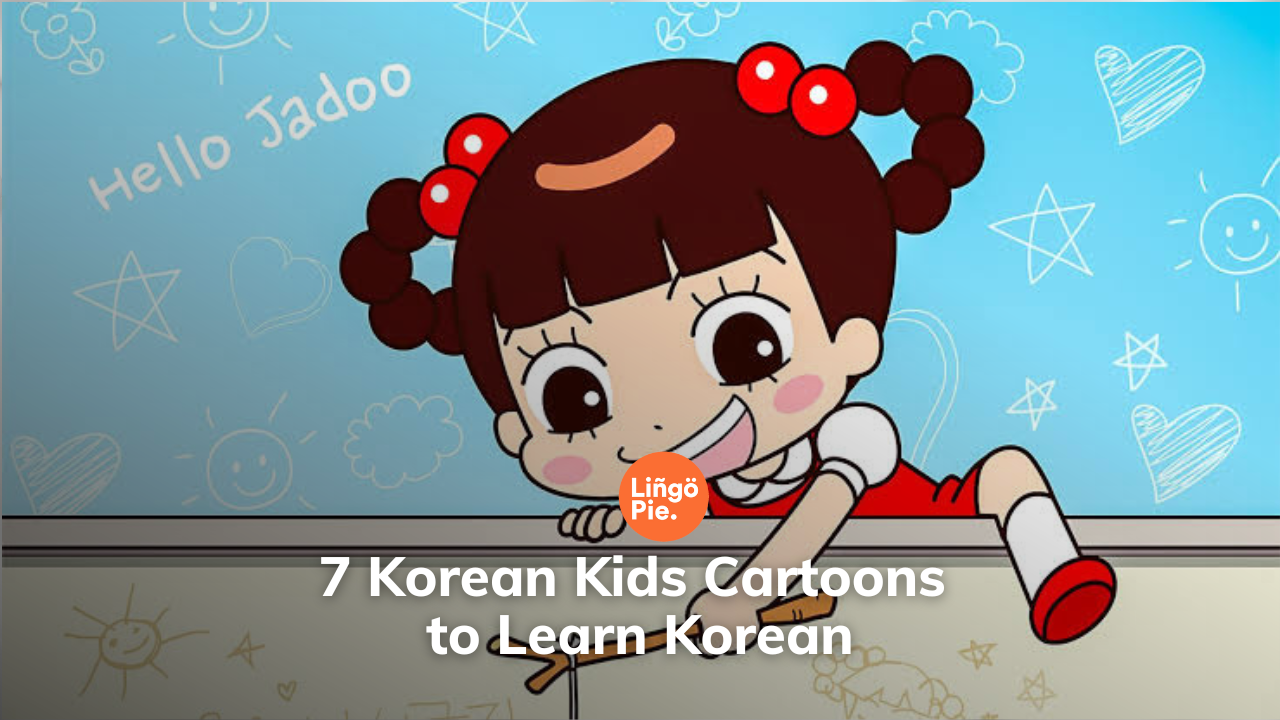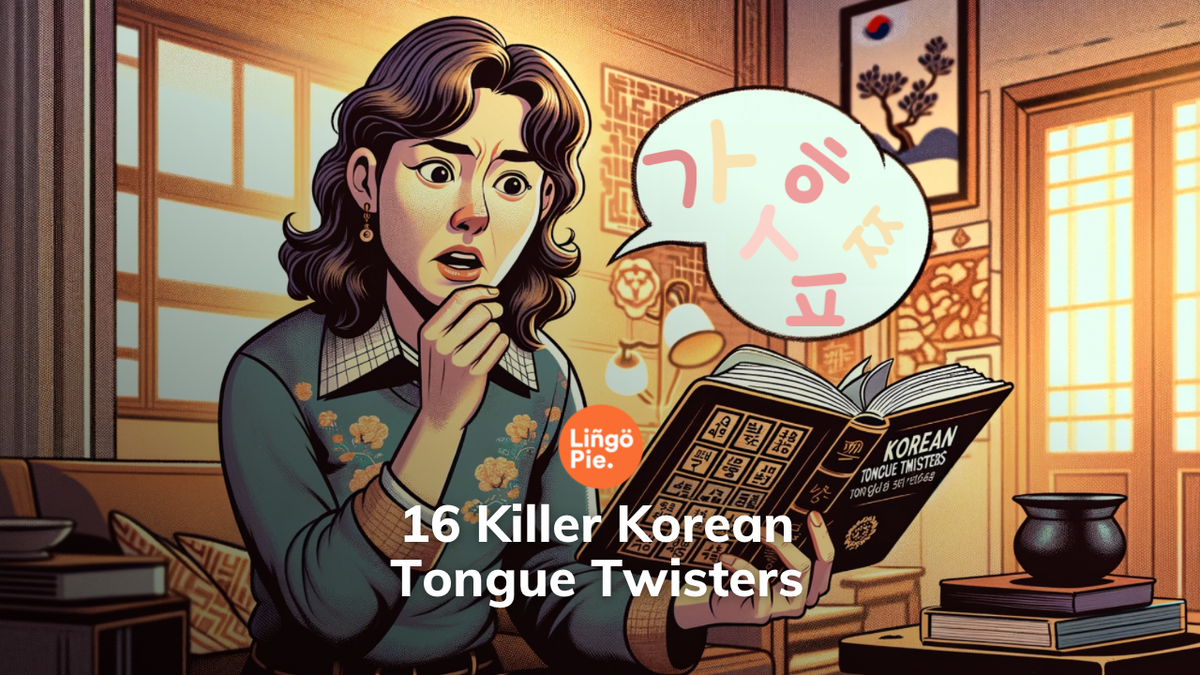In this guide to killer Korean tongue twisters, you’ll discover the joy of anunciation and pronunciation in Korean while immersing yourself in the rich culture and life of Korea.
These Korean tongue twisters promise not just linguistic challenges (as an understatement…) but also a glimpse into the fascintating intricacies of the Korean language.
Get ready to master the art of pronunciation and expand your vocabulary in an entertaining and engaging way.

1. "경찰청 철창살은 외철창살이고 검찰청 철창살은 쌍철창살이다"
Romanization: Gyeong-chal-cheong cheol-chang-sa-reun noe-cheol-chang-sa-ri-go geom-chal-cheong cheol-chang-sa-reun ssang-cheol-chang-sa-ri-da.
Translation: The iron bar windows at the police headquarters are single-layer iron bars, whereas those at the prosecutor’s office are double-layer iron bars.
What's Interesting: This is one of the Korean tongue twisters that lets you explore the legal landscape of Korea.
@xum.o 출장 십오야 | 서명호 입덕 모먼트 1 #세븐틴 #서명호 #디에잇 #입덕모먼트 #추천
♬ 오리지널 사운드 - 서맹호 - 먕호
2. "네가 그린 기린 그림은 못 그린 기린 그림이고 내가 그린 기린 그림은 잘 그린 기린 그림이다."
Romanization: Ne-ga geu-rin gi-rin geu-ri-meun mot geu-rin gi-rin geu-ri-mi-go nae-ga geu-rin gi-rin geu-ri-meun jal geu-rin gi-rin geu-ri-mi-da.
Translation: Your drawing of a giraffe is a poorly done drawing of a giraffe, but mine is a well-drawn drawing of a giraffe.
What's Interesting: Here you can witness the artistic prowess through this tongue twister, showcasing the art of expression and individuality.
3. "저기 저 뜀틀이 내가 뛸 뜀틀인가 내가 안 뛸 뜀틀인가"
Romanization: Jeogi jeo tteomteuri naega ttwil tteomteuringa naega an ttwil tteomteuringa?
Translation: Is that hurdle over there one that I will jump over, or is it one that I will not jump over?"
@tiktok_stage His cute pronunciation challenge! #TikTokStageConnect #틱톡스테이지커넥트 #SeoKangJun #서강준 #OneCozyNight #어느편안한밤 #tiktokstage #틱톡스테이지 #kpop #fyp
♬ 오리지널 사운드 - TikTok K-ENT - TikTok Stage
4. "간장 공장 공장장은 장 공장장이고 된장 공장 공장장은 강 공장장이다."
Romanization: Gan-jang gong-jang gong-jang-jang-eun jang gong-jang-jang-i-go doen-jang gong-jang gong-jang-jang-eun gang gong-jang-jang-i-da.
Translation: Factory manager Jang is in charge of the soy sauce factory, and factory manager Kang is in charge of the bean paste factory.
What's Interesting: Use this tongue twister as a way to learn about the neverending flavors
and culinary delights of Korean cuisine.
5. "서울특별시 특허허가과 허가과장 허 과장."
Romanization: Seo-ul-teuk-byeol-si teu-keo-heo-ga-gwa heo-ga-gwa-jang heo-gwa-jang.
Translation: Chief Heo of Seoul Metropolitan City‘s patent issuing section authorization.
What's Interesting: This is one of the best Korean tongue twisters that let you dive into the world of patents and intellectual property. If that’s how you want to spend your time, of course!
6. "고려고 교복은 고급 교복이고 고려고 교복은 고급 원단을 사용했다"
Romanization: Gohryeogoh gyo-pog-eun go-geub gyo-pog-i-go gohryeogoh gyo-pog-eun go-geub won-dan-eur sa-yong-haess-da.
Translation: Gohryeogoh uniforms are of high quality, and the materials used to make them are also of high quality.
What's Interesting: Here you will learn about Korean fashion and craftsmanship, appreciating the attention to detail in school uniforms. South Koreans are known for their high dress standards and great sense of fashion.
7. 멍멍이네 꿀꿀이는 멍멍해도 꿀꿀하고 꿀꿀이네 멍멍이는 꿀꿀해도 멍멍하네
Romanization: Meongmeong-ine kkulkkuli-neun meongmeonghaedo kkulkkulhago, kkulkkuli-ne meongmeongi-neun kkulkkulhaedo meongmeonghane
Translation: there is not many meaning, just 멍멍이 = childish word of Dog
꿀꿀이 = childish word of Pig 멍멍 = dog’s sound, 꿀꿀 = pig’s sound
8. "저기 있는 저분은 백 법학박사이고 여기 있는 이분은 박 법학박사이다"
Romanization: Jeobun-eun baeg beobhagbagsaigo ibun-eun bag beobhagbagsaida.
Translation: That is Mr. Baek, a doctor of law, and this is Mr. Park, also a doctor of law.
What's Interesting: This is one of the Korean tongue twisters that help you get a better knowledge about the legal landscape of Korea through the lens of accomplished individuals in the field of law. Not got time for that? Well, use this one to impress Korean friends at dinner!
9. "체다치즈를 최고 많이 먹은 최다은이 체다치즈 먹기 대회 최다 우승자이다."
Cheese Lover's Dilemma: Romanization: Chedachijeureul choego mani meogeun choedaeuni chedachijeu meokgi daehoe choeda useungjaida.
Translation: Choi-Da-Eun won the cheddar cheese eating contest because he ate most of the cheese.
What's Interesting: Here you will learn and experience the joy and intensity of a Korean cheese-eating competition, exploring unique cultural events.
10. "박범복 군은 밤 벚꽃놀이를 가고 방범복 양은 낮 벚꽃놀이를 간다."
Cherry Blossom Adventures: Romanization: Bakbeombokguneun bambeotkkonnorireul gago bangbeombogyangeun natbeotkkonnorireul ganda.
Translation: Park Beom-bok goes to the cherry blossoms at night, and Bang Bum-bok goes during the day.
What's Interesting: This is one of the Korean tongue twisters where you will get a better insight into Korean nature and traditions, journeying through the enchanting world of cherry blossoms.
11. "육통 통장 적금 통장은 황색 적금 통장이고 팔통 통장 적금 통장은 녹색 적금 통장이다."
Romanization: Yug-tong tong-chang cheog-geum-tong chang-uen hwang-saeg cheog-geum-tong-chang-i-gop’ar-tong tong-chang cheog-geum-tong chang-uen nog-saeg cheog-geum-tong-chang-i-da.
Translation: Six dong bank book savings book is the yellow bank savings book, and eight dong bank book savings book is the green bank savings book.
What's Interesting: No fun fact here, but - seriously - how fun would it be to learn this Korean tongue twister?
12. "육통 통장 적금 통장은 황색 적금 통장이고 팔통 통장 적금 통장은 녹색 적금 통장이다."
Culinary Delights Unveiled: Romanization: Mokdong ro-yal nyu-ro-yar re-seu-t’o-rang nyu-me-nyu mi-teu-so-shi-chi-so-seu-seu-p’a-ge-t’i, k’eu-rim-so-shi-chi-so-seu-seu-t’e-i-keu.
Translation: Mokdong Royal’s new menu includes meat sausage sauce spaghetti and cream sausage sauce steak.
What's Interesting: This one provides a glimpse into the neverending culinary delights of Korea.
13. "저 철창의 쇠창살은 새 쇠창살이다."
Prison Room Mysteries: Romanization: Jo cholchange swechangsareun sae swechangsarida.
Translation: The steel bars of that prison room are new steel bars.
What's Interesting: With this one you can navigate the mysteries of a Korean prison room, delving into the intriguing world of law enforcement.
14. "들의 콩깍지는 깐 콩깍지인가 안깐 콩깍지인가. 깐 콩깍지면 어떻고 안 깐 콩각지면어떠냐. 깐 콩깍지나 안 깐 콩깍지나 콩깍지는 다 콩깍지인데..."
Bean Pod Dilemma: Romanization: Deure kongkkakjjineun kkan kongkkakjjiinga ankkan kongkkakjjiinga kkan kongkkakjjimyon ottoko an kkan konggakjjimyonottonya kkan kongkkakjjina an kkan kongkkakjjina kongkkakjjineun da kongkkakjjiinde.
Translation: Are their pods peeled or unpeeled pods? What’s wrong with peeled beans? What’s wrong with not peeled beans? Pea pods, whether they’re peeled or not, are pea pods.
What's Interesting: It’s the only tongue twister we’ve been able to find relating to beans!
15. 저기 있는 말뚝이 말 맬 말뚝이냐, 말 못 맬 말뚝이냐?
Romanization: Jeogi inneun malttuki mal mael malttukinya, mal mot mael malttukinya?"
Translation: Is that stake over there a horse or a horse?
@ateez_official_ ANEWZ 시작 전, 정앵커의 연습시간🎙 #ATEEZ #에이티즈 #윤호 #YUNHO
♬ 오리지널 사운드 - ATEEZ_Official - ATEEZ_Official
16. "안 촉촉한 초코칩 나라에 살던 안 촉촉한 초코칩이 촉촉한 초코칩 나라의 촉촉한 초코칩을 보고 촉촉한 초코칩이 되고 싶어서 촉촉한 초코칩 나라에 갔는데 촉촉한 초코칩 나라의 문지기가 “넌 촉촉한 초코칩이 아니고 안 촉촉한 초코칩이니까 안 촉촉한 초코칩 나라에서 살아”라고 해서 안 촉촉한 초코칩은 촉촉한 초코칩이 되는 것을 포기하고 안 촉촉한 초코칩 나라로 돌아갔다."
Get ready for this one…
Moist vs. Non-Moist Cookie Chronicles: Romanization: An chok-chok-han cho-ko-chip na-ra-e sal-deon an chok-chok-han cho-ko-chip-i chok-chok-han cho-ko-chip na-ra-ui chok-chok-han cho-ko-chip-eul po-go chok-chok-han cho-ko-chip-i doe-go ship-eo-seo chok-chok-han cho-ko-chip na-ra-e ka-neun-de chok-chok-han cho-ko-chip na-ra-ui mun-ji-gi-ga “neon chok-chok-han cho-ko-chip-i a-ni-go an chok-chok-han cho-ko-chip-i-ni-kka an chok-chok-han cho-ko-chip na-ra-e-seo sal-a”ra-go-hae-seo an chok-chok-han cho-ko-chip-eun chok-chok-han cho-ko-chip-i doe-neun got-eul po-gi-ha-go an chok-chok-han cho-ko-chip na-ra-ro dol-a-gat-da.
Translation: A non-moist chocolate chip cookie that lived in non-moist chocolate chip cookie land saw a moist chocolate chip cookie from moist chocolate chip cookie land and wanted to become a moist chocolate chip cookie and so went to moist chocolate chip cookie land, but the gate-keeper of moist chocolate chip cookie land said, “You are not a moist chocolate chip cookie, but a non-moist chocolate chip cookie, so live in non-moist chocolate chip cookie land,” so the non-moist chocolate chip cookie gave up on becoming a moist chocolate chip cookie and went back to non-moist chocolate chip cookie land.
What's Interesting: This is by far the most complicated on our list of Korean tongue twisters!
Learning Korean With Lingopie
Learning Korean with Lingopie can be both an enjoyable and effective experience, especially for those who love immersing themselves in authentic media content. To start, sign up for LingoPie and choose Korean as your language of study. Once you're set up, dive into a diverse range of Korean TV shows and movies available on the platform.
As you watch, you'll see subtitles in both Korean and your native language, making it easier to follow along and understand the context. Take advantage of the interactive features: click on any word in the subtitles to see its translation and hear its pronunciation, and add it to your personal vocabulary list for later review. Regularly engaging with the content helps in improving listening comprehension and expanding vocabulary.
For a more structured learning approach, use the supplementary materials like quizzes and flashcards provided by LingoPie, which reinforce the language learned from the shows. Remember, consistency is key, so try to watch a little every day to steadily improve your Korean language skills.
FAQs Regarding Famous Korean Tongue Twisters
Now that you know the most important tongue twisters we can focus on commonly asked questions like :
Is Korean easy to learn?
Learning Korean can be challenging due to its unique script and grammar. However, with dedication and consistent practice, many find it manageable and rewarding.
Can I learn Korean with Lingopie?
Yes, Lingopie offers a Korean catalog for you to learn from. While it's a useful supplement, combining it with other resources like textbooks, language exchange, and immersive content enhances overall learning.
Related:



How do I start learning to speak Korean?
Start with the Korean writing system, Hangul. Then, focus on basic vocabulary and grammar. Engage in regular listening and speaking practice, consider language exchange, and use interactive learning apps.
Is KoreanClass101 legit?
Yes, KoreanClass101 is a reputable platform offering structured lessons, audio content, and various resources for learning Korean. Many learners find it beneficial for developing language skills and cultural understanding.
Summing Up
Learning more about the Korean language and culture becomes an exciting journey with these killer tongue twisters.
Beyond linguistic benefits, they unravel aspects of Korean life, from legal intricacies to culinary delights. Embrace the challenge, as every twist and turn contributes to a deeper understanding of the language.
As you navigate the labyrinth of sounds, you not only refine your pronunciation but also gain cultural insights. Let these tongue twisters be your guide to an immersive language experience, proving that language learning can indeed be a delightful adventure!





![7 Tips to Improve Portuguese Pronunciation [2025 Guide]](/blog/content/images/2024/01/CC820D56-4A15-4CE6-B237-765BE63A2738.png)

![11+ Best Shows On Netflix To Learn Korean [2025]](/blog/content/images/size/w300/2025/05/Best-Shows-On-Netflix-To-Learn-Korean.jpg)


